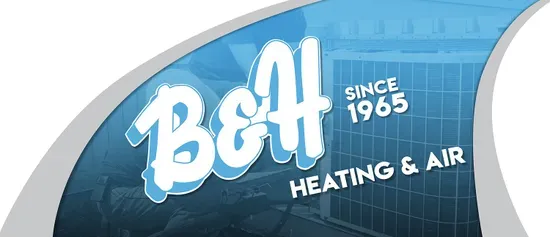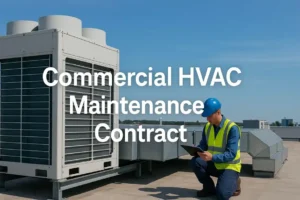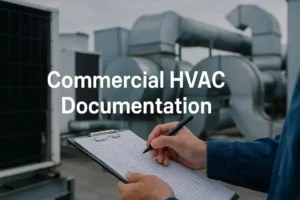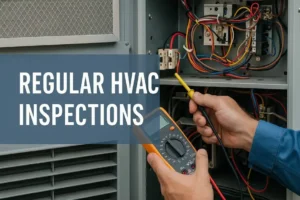Blog Contents
If you are planning to upgrade your heating and cooling system this year, the 2025 HVAC tax credit could offer significant savings. Under the Inflation Reduction Act, homeowners may qualify for federal tax credits when they install certain energy-efficient HVAC systems in their primary residences.
These incentives are part of a broader effort to lower energy use and reduce carbon emissions while helping families cut utility costs.
In simple terms, if you install a qualifying high-efficiency system in 2025, you could receive a nonrefundable tax credit of up to 30 percent of the total cost, capped at set amounts depending on the equipment type.

Let’s take a closer look at what qualifies and how to make sure you claim your credit successfully.
Qualifying Systems: What’s Eligible This Year?
Not all HVAC systems are eligible for these incentives. The systems that qualify for the 2025 tax credit include:
- Central air conditioners that meet high-efficiency requirements
- Air-source and geothermal heat pumps
- Gas, oil, or propane furnaces that meet ENERGY STAR standards
- Advanced ductless mini-split systems
- Geothermal heat pumps that qualify for specific geothermal HVAC tax incentives
These systems must be installed in your primary residence within the U.S. Secondary homes and rental properties generally do not qualify.
Energy Efficiency Standards You Need to Know
To qualify for the 2025 energy-efficient HVAC tax credit, your system must meet or exceed government-mandated efficiency thresholds. These requirements are updated each year to reflect advances in technology.
For 2025, qualifying systems must:
- Be ENERGY STAR certified
- Meet specific SEER2, HSPF2, and EER2 ratings depending on the system type
- Be installed by a certified HVAC professional
Meeting these standards ensures the system will reduce long-term energy use, which means lower monthly bills in addition to the one-time tax credit.
SEER2, HSPF2, and EER2: Breaking Down the Ratings
Energy efficiency ratings can be confusing, so here’s a quick guide to the three most important:
- SEER2 (Seasonal Energy Efficiency Ratio 2): Measures cooling efficiency. The higher the SEER2, the more efficient the system. For central AC, a minimum SEER2 of 15.2 is generally required in 2025.
- HSPF2 (Heating Seasonal Performance Factor 2): Measures heating efficiency for heat pumps. For tax credit eligibility, look for a minimum HSPF2 of 7.5.
- EER2 (Energy Efficiency Ratio 2): Reflects peak cooling efficiency on the hottest days. Requirements vary by region but often exceed 12.5 EER2.
These ratings are what determine if your system qualifies for the federal tax credit.
Top HVAC System Types That May Qualify
1. High-Efficiency Central Air Conditioners
Systems that meet ENERGY STAR standards and are rated 15.2 SEER2 or higher are eligible. If you are exploring a 2025 central air conditioner tax rebate, start here.
2. Air-Source Heat Pumps
These are popular with homeowners because they provide both heating and cooling. Many qualify for the maximum 30 percent tax credit.
3. Geothermal Heat Pumps
By using stable ground temperatures, these systems provide highly efficient heating and cooling. While they can be costly upfront, they qualify for geothermal HVAC tax incentives and offer excellent long-term efficiency.
4. Furnaces and Boilers
Select high-efficiency models powered by gas, oil, or propane may qualify, especially those with the ENERGY STAR label.
How to Claim the Credit: Documentation and Steps
Here’s how to claim the 2025 HVAC tax credit:
- Confirm Eligibility: Verify that your system meets the 2025 federal efficiency standards. Ask your installer for written proof.
- Keep All Documentation: Save product receipts, installation invoices, manufacturer’s certification statements or AHRI certificates, and ENERGY STAR labels or technical specs.
- Complete IRS Form 5695: This form allows you to claim the residential energy tax credit. Submit it with your 2025 tax return.
- Retain Records: The IRS recommends keeping related documents for at least three years in case of an audit.
Tips for Choosing an Energy-Efficient HVAC System in 2025
Upgrading your HVAC system should be about more than just the tax break. You want a system that matches your home’s size, your climate, and your energy goals. Consider these tips:
- Work with a certified HVAC contractor to calculate the correct system capacity
- Ask for SEER2, HSPF2, and EER2 ratings before making a decision
- Compare ENERGY STAR-certified products from different brands
- Look into local and state HVAC rebate programs
- Focus on long-term energy savings rather than only the lowest upfront price
Get the Most Out of Your Upgrade: Comfort and Savings
Installing a qualifying HVAC system in 2025 is a smart move for both your comfort and your wallet. With the Inflation Reduction Act HVAC credit, you can enjoy lower energy bills, improved indoor comfort, and a reduced carbon footprint.
The team at B&H Heating and Cooling can help you find the best system for your needs, navigate available rebates, and handle the installation process from start to finish.
Contact us today to learn how you can take advantage of the 2025 HVAC tax credit and enjoy a more efficient home for years to come.






